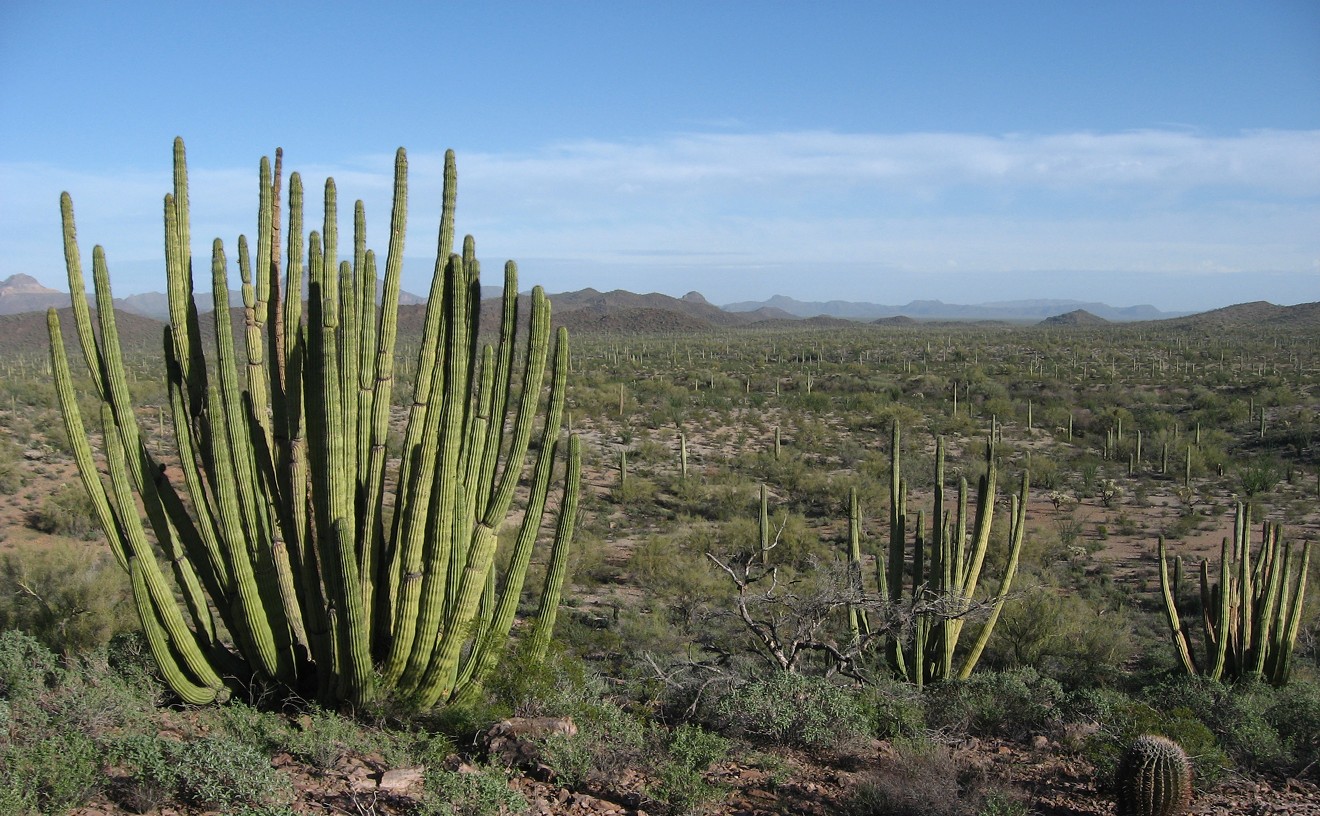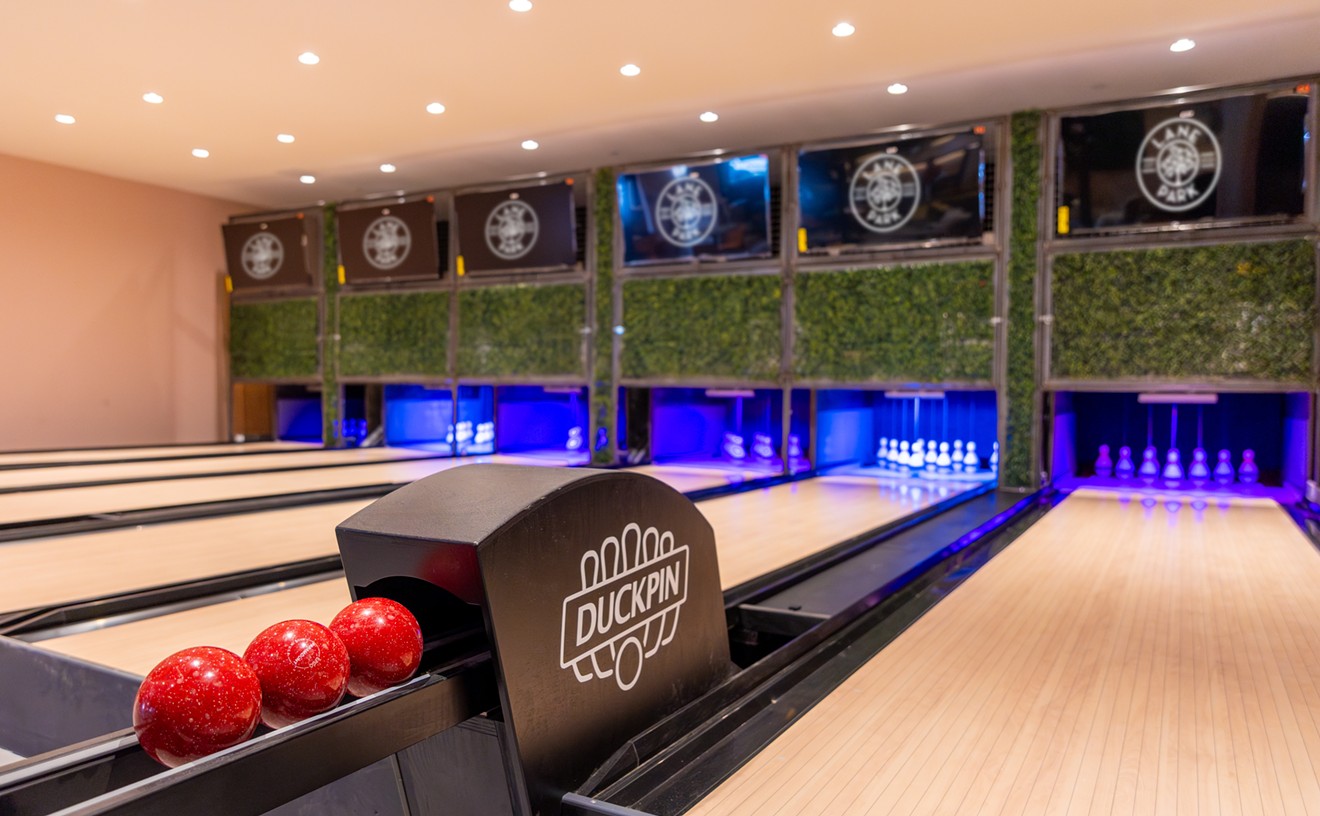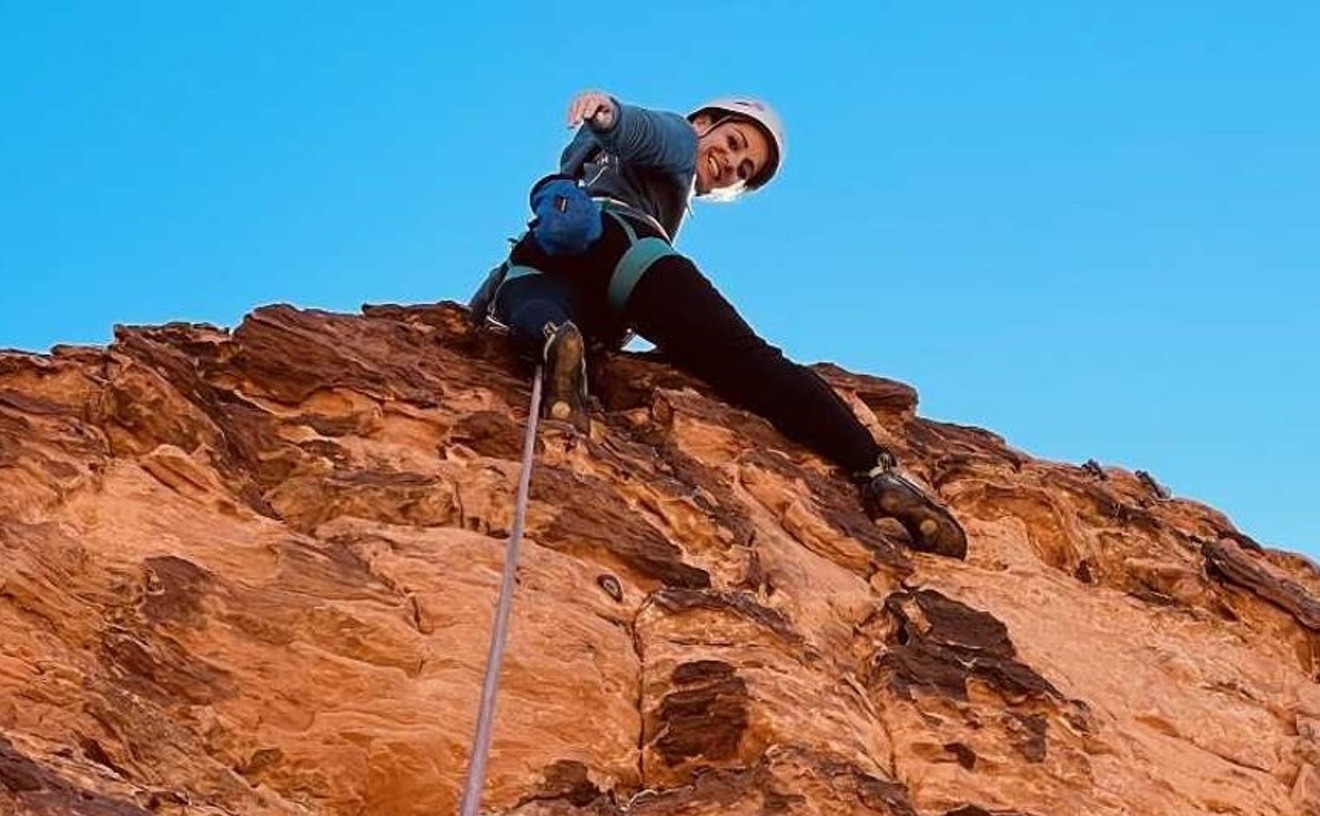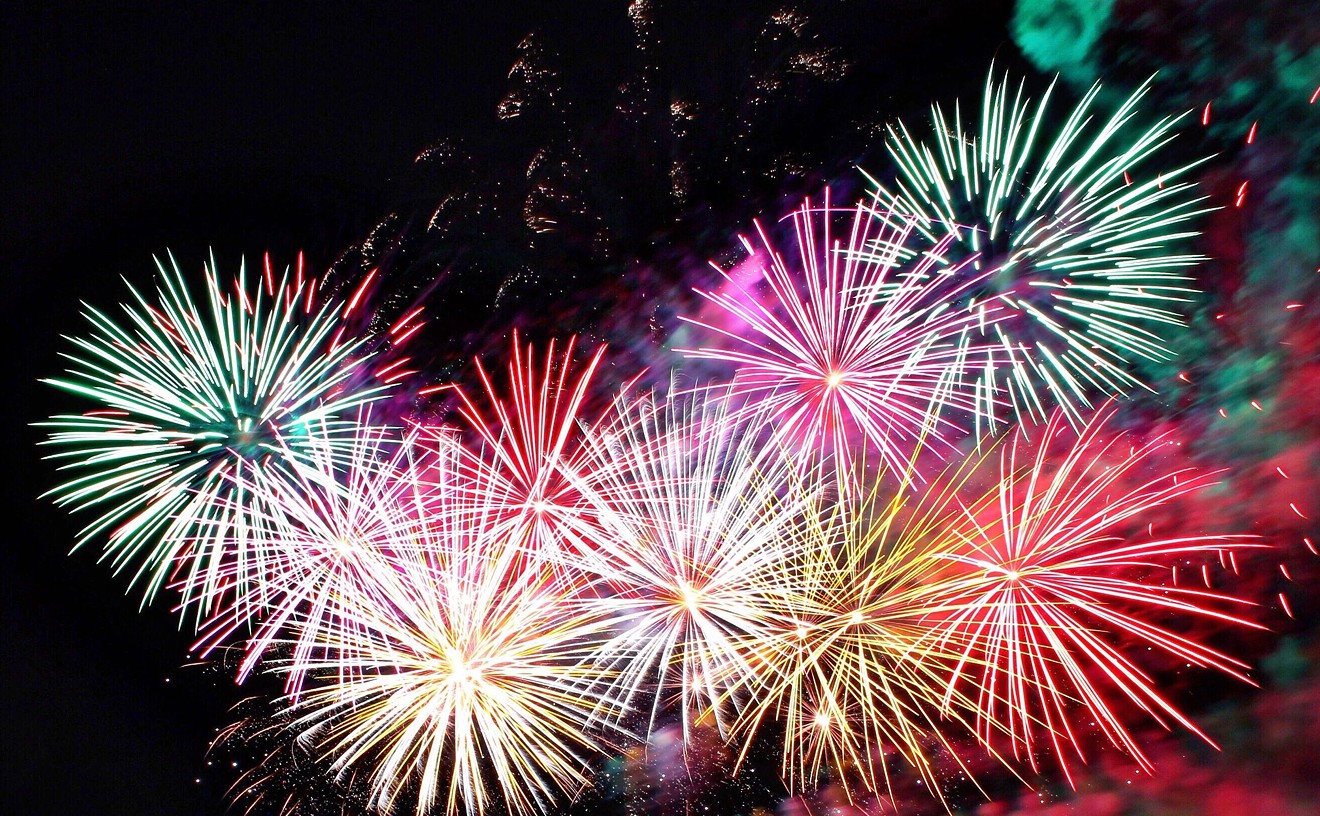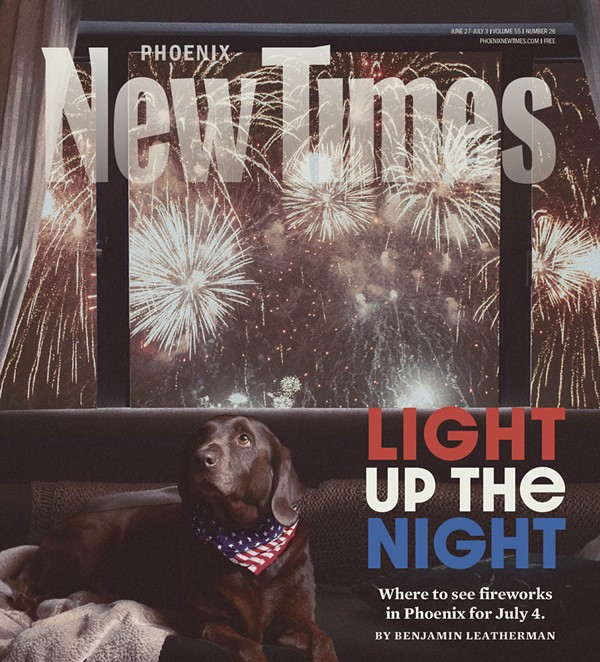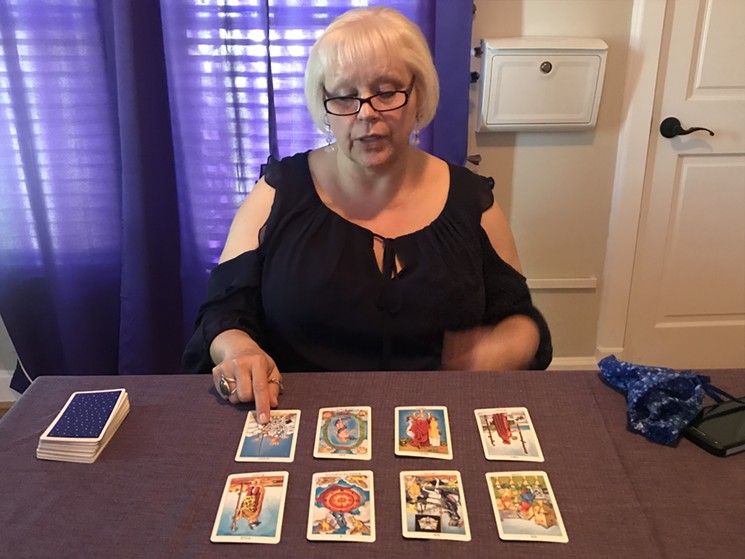
Psychic Christinia Brown of Rising Phoenix Spiritualist Church and Metaphysical Community reads tarot cards.
Lynn Trimble
It’s Friday the 13th as people converge on a metaphysical bookstore in Phoenix. They’ve come for a psychic panel, where four readers sit side by side at a small table, ready to answer a single question or give a psychic impression to everyone who’s seated in three rows before them.
But first, the ground rules.
They’re delivered by a tall, imposing man named Apollo, who identifies himself as a metaphysician, psychic, UFO researcher, and healer.
Dressed in black, he stands behind a podium and explains that the psychics will be giving general impressions of what they’re experiencing, leaving listeners to use their own intuition about how it all applies to their own life.
“No psychic is 100 percent accurate,” he says.
That doesn’t dissuade his listeners, who’ve paid $15 each to participate that night. During the course of an hour, they seek input on relationships, careers, and a variety of life changes.
And they get a heavy dose of self-help mantras, including several from a psychic named Dan. Sporting a white polo shirt, dark pants, and sneakers, he’s a far cry from the stereotypical image of a psychic donning a turban while gazing into a crystal ball.
“You’re creating the blockage yourself,” he tells one person. “Be careful you don’t put too much energy into what you don’t want,” he urges another.
His advice echoes the themes reflected in the store’s eclectic assortment of books — covering topics such as astrology, healing, alternative medicine, channeling, and self-help. Even PMS and financial abundance get shelf space.
The store is also filled with various tools used in alternative spirituality, such as crystals, candles, singing bowls, tarot cards, and statues of beings from archangels to fairies.
It’s a reminder that metaphysical spirituality takes many forms — including the belief in psychic powers.
Nowadays, psychics abound in Phoenix.
Signs advertising psychic readings pop up nearly as often as Starbucks stores, but without the drive-thru lanes that would make tarot time more convenient for anxious millennials.
There’s no way to count the number of psychics in Phoenix, says Michael Erwin. He’s the owner of Fantasia Crystals, a second-generation business that caters to people who practice alternative spirituality, whether through yoga, candle rituals, chakra cleansing, or other means.
The term chakras refers to seven energy centers that run from the top of the head to the bottom of the spine, by the way. Each has its own unique vibration psychics work to keep in balance. Every chakra is represented by a different color, starting with purple at the top, which represents self-knowledge. That’s one reason you’ll see so much purple while you’re hanging out at metaphysical bookstores or psychic fairs.
In any event, there’s at least one significant barrier to figuring out how many Phoenicians consider themselves psychics. “Most psychics operate independently and do their own thing,” Erwin says.
Only a couple dozen psychics do readings through the main psychic stores in town, including Vision Quest, Fantasia, and Tree of Life Metaphysical in Gilbert. Hundreds more attend psychic fairs, but no one officially tracks their numbers.
The more fascinating question is this: Why are all these psychics, and the people who use them, drawn to Phoenix?
What is it about the Valley of the Sun that makes this type of alternative spirituality thrive?
The most obvious answer is location, location, location.
Phoenix sits just over 100 miles south of Sedona, a city hailed by many as the site of energy vortexes with transformative powers.
Indigenous peoples discovered it thousands of years ago, but its global status as a hub of alternative spirituality is a far more recent affair.
Believers flocked to Sedona in 1987 as part of a global meditation event called the Harmonic Convergence. It’s been a hotbed of New Age tourism ever since, helping to draw psychics and their clientele to the state.
“We can all congregate here, and still feel the vortexes,” says Dylan, a Vision Quest psychic who goes by just her first name.
There’s another geographic factor, as well.
It’s our proximity to Los Angeles, another city where psychics abound. “It’s hectic and crazy in Los Angeles, but Phoenix has a flow about it,” Dylan says. “People bring their practice here because there’s a calm and open environment where they can share their gifts.”
Most psychics are concentrated around urban centers, according to Jodie Vann, an assistant professor of religion at Dickinson College in Carlisle, Pennsylvania, who holds a Ph.D. in religious studies from Arizona State University. “It’s generally an urban phenomenon,” she says. “One of my theories is that it’s because urban places are racially, ethnically, and religiously diverse.”
That diversity fuels the exchange of eclectic ideas. “When you get different ideologies in one place, people talk to each other, and it becomes harder for people to think that only their own ideas are valid.”
Psychics are more prevalent in the western half of the country, she says. “Oregon, Washington, California, and Arizona are more open to this.”
There’s also the desert factor, according to Paige Ashmore. She’s an artist whose intuitive readings include pastel drawings of clients’ past lives.
“There are a lot of stories about the masters going into the desert,” Ashmore says. “The heat burns you down to your bones, and your essential truth and self is there.”

Paige Ashmore believes the desert heat draws psychics and spirituality-seekers to Phoenix.
Lynn Trimble
There’s something else at play.
“Phoenix is an immigrant city, and folk religions have flourished among Hispanic communities,” Vann says. “Many Hispanic Catholics don’t have a problem merging different traditions into their Catholic identities.”
Yet, that’s not always the case.
Patricia Federico is a Phoenix-based curandera. That’s a medicine woman in Latino culture, and there are several different types. Federico’s gift is psychic ability, she says. That includes reiki healing, in which a practitioner’s hands convey psychic energies. Sometimes it’s performed on a traditional massage table; other times, clients sit on a chair facing away from the practitioner.
Federico works inside a small house located at The Farm at South Mountain, where two maroon chairs face each other in front of a small altar. Nearby is her healing table, and there’s a kitchen table in another room for having those first conversations with people before they’re ready to dive into the serious work.
“Most curanderas in Phoenix aren’t very transparent that they do this work,” she says. So you won’t find their signs popping up like fast-food restaurants. “Some Latina psychics don’t come out because they’re afraid of how they’ll be viewed by the religious community, but I think it’s really important that the community know it’s a healing art, and it’s safe.”
She’s hoping the surge in interest about precognitive powers will help change that. “I’d like to see more indigenous communicators come out, and be more visible and transparent,” Federico says. Curanderismo is for everyone, she says, but only indigenous people should practice it. The same goes for shamans and other indigenous healers. “It’s passed through the bloodline, so an Anglo person can’t just take some classes and travel to Peru, then legitimately call herself a shaman.”
Cultural appropriation is a problem, but Federico is fine with intertwining different cultures. It’s bound to happen in a global society, according to Devon Leal Bridgewater, a doctoral candidate at ASU who teaches Chicano history and culture at Phoenix College. Take a spin around almost any metaphysical space, and you’ll see the sage burned in Native American culture, for example, along with the feathers used to spread the smoke.
There’s a long list of reasons people turn to psychics.
Sometimes, it’s a simple search for meaning.
“I think people are just looking for ways to make sense of things that happen to them,” says Hannah Irene Walsh. She’s an artist based at Oasis on Grand, where her walls are covered in fantasy drawings that reflect her metaphysical beliefs.
Walsh is part of a two-person collective called Ordo Helicali, which leads periodic discussions on divination and the occult at ThirdSpace, where they also do tarot card readings.
“They’re a little bit like therapy sessions,” she says of the readings. “Cards are a tool for shifting your perspective, linking to new ideas, and making connections in a disconnected world.”
It’s not just about the spirituality, but being with similarly minded people, too. Sometimes there’s a bit of a boredom factor, Walsh says. Or just good old-fashioned curiosity.
Christinia Brown of Mesa uses tarot cards in her readings, too. She’s part of the Rising Phoenix Spiritualist Church and Metaphysical Community, situated inside a house in the Encanto neighborhood in Phoenix. People gather there on Wednesday nights and Sunday mornings, for readings and reiki healing.
It’s pretty easy to spot, because there’s a large spiral of rocks in the front yard, instead of a lawn. A subtle sign near the small porch for the red brick building lets people know it’s a spiritual center rather than a home.
During one Sunday morning in July, about two dozen people gathered inside. They sat in rows of chairs, including a final row that faced all the others. An aisle ran by the odd-facing row, where people walked to and from the reiki room for healings. Brown sat in another room, where she turned over eight cards for the woman who sat before her.
Arranged in two rows of four cards, they included the death card. But Brown explained that the death card doesn’t necessarily mean the client needs to run out and buy a gravestone. Instead, she said, it’s a card that signals transformation.
Besides the significance of the particular cards that get drawn, she explained, readers also look for relationships among the cards. Several cards with circle shapes might mean the client is coming full circle with an important issue, for example.
The church draws people from all over the state, Brown says. And it reflects the fact that so few people who live in Arizona were actually born here.
“A lot of people are transplanted here, and they’ve walked away from another belief system,” Brown says. “I see a lot of folks from all walks of life who want to find their own path.”
For Brown, that meant finding an alternative to her Mormon heritage.
It all makes sense, at least in theory. But it’s hard to square with Arizona’s political landscape.
Anyone familiar with former Sheriff Joe Arpaio’s history of racial profiling, or the Tucson school board’s decision to nix Chicano studies, knows that Arizona is a repository of conservative rhetoric.
So you have to wonder: How can psychic practitioners coexist with conservative politicians?
Sunny, another psychic who does readings at Vision Quest, chalks it up to Arizona’s libertarian streak. “The better part of the population has a live-and-let-live attitude.”
Turns out, the support for freedom from government regulation is something most Arizona psychics and politicians have in common, she says.
There’s also a free-thinking phenomenon rooted in American history. Consider the case of two former presidents, Dickinson professor Vann says. Thomas Jefferson edited his own take on the Bible, and Abraham Lincoln held seances in the White House after his young son died.
Even the Wild West mentality plays a role, according to Erin McNamara, a psychic who operates Purple Lotus Productions with her daughter, Robin Selby.
“Arizona was created by badasses,” McNamara says. “There were outlaws, people seeking gold, army deserters, cowboys, saloon chicks, and women raising kids alone on the frontier.”
At least in part, psychic Phoenix signals the intersection of Old West with New Age.
On the national level, First Lady Nancy Reagan turned to astrology in the aftermath of an assassination attempt on her husband, President Ronald Reagan. She took a lot of grief for it, but she was hardly alone.
Psychic practice grew in America during the 1950s and 1960s, and became an important part of the hippie movement. In the 1980s, New Age was all the rage. And it’s been going strong ever since.
Fifteen percent of Americans have consulted a fortune teller or psychic, according to a 2009 Pew Research Center report. That includes one in 10 men, and two in 10 women. Democrats and liberals reported seeing a fortune teller more often than Republicans and conservatives.
Americans are embracing supernatural phenomena as well, according to results of a Gallup survey released in 2005.
The report notes that 41 percent of Americans believe in extrasensory perception or ESP; 31 percent believe in telepathy or communicating without using traditional senses; and 26 percent believe in clairvoyance and the mind’s power to both know the past and predict the future. Just 21 percent believe that people can communicate with the dead, and 9 percent believe in channeling spirits through the body.
In recent years, psychic characters and ideas have infiltrated mass media and pop culture — including TV, film, music, and books. The short list includes TLC’s Long Island Medium and Stephen King’s The Shining.
Even Arizona made its mark when NBC launched a show called Medium in 2005, which starred Patricia Arquette as Allison DuBois, a Phoenix medium pulled in to help solve cases.
“Sometimes they help people learn more, and be less fearful,” Brown says. “They’re gateway drugs for us.”
It’s all made admitting you’re a psychic, or visiting a psychic, more acceptable, according to Jamie Clark. His practice includes working on criminal cold cases, and searching for things like oil and gold mines.
But there’s a downside to psychics being so popular, Clark says, mainly an increase in the number of frauds and con artists.
Most psychics liken them to the bad apples you find in every other profession, from doctors to car salesmen.
“I’ve seen people get scammed for thousands of dollars,” Erwin says. Beware of anyone who says you’ve got a curse, then insists they’re the only one who can lift it. Genuine psychics won’t claim you need them to intercede on your behalf, he says.
Maybe you’re not into metaphysics, but you’re still intrigued by things like tarot cards. If so, it’s pretty easy to find places where you can dabble.
Last December, the Fortoul Brothers presented an exhibition of tarot card-sized drawings called “Total Eclipse” at Shortcut Gallery. And Adriene Jenik, an artist and ASU faculty member who previously headed the university’s School of Art, created a tarot deck she uses to read climate futures.
In March, Shortcut Gallery showed works by Tara Logsdon, based on her original drawings for a deck of tarot cards that includes a guide book by L.A. crystal healer Naha Armády. Armády did readings with the cards during the packed opening reception.
Most First Fridays, you’ll find Scottsdale-based Bob the Psychic doing tarot card readings in a parking lot near the southeast corner of Fourth and Roosevelt streets.
But for skeptics like Stefanie Northover, a graduate research assistant in the psychology department at ASU who will teach a class called Defective Thinking this fall, there’s no truth behind psychics’ claims.
Typically, psychics claim to either read your mind, predict future events, or communicate with dead people, Northover says. She’s not buying it. Instead, she points to psychological techniques that make psychics seem convincing.
Sometimes they’ll state things that apply to most people, like telling a client they get shy occasionally despite being social, she says. Or they go fishing by putting statements in question form, knowing clients will respond with information they can use.
Or they rely on clients doing something called “subjective validation,” which basically means hearing a statement then finding a way to make it right.
Either way, clients tend to remember a psychic’s hits rather than misses once they get back home or recount the experience to someone else, Northover says. That’s called “confirmation bias.”
That doesn’t faze psychic practitioners, or their hardcore fans.
A woman named Heather Windle is among them. When Heather’s aunt took her to see a psychic in Denver about 10 years ago, the psychic did a spread of tarot cards. Heather recalls bursting into tears after the psychic talked about getting a bad headache and smelling alcohol. Years earlier, Heather’s father committed suicide while drinking heavily.
“I always thought they were full of shit before that,” Heather says. “But there’s no way for them to know what they know without being psychic.” Since then, she’s done two additional readings, each with a different psychic. And she finally dumped the boyfriend the first psychic told her was bad news.
Suellen Dornbos is another believer. Recently she sat across a small table from Paige Ashmore inside a cozy room at Tree of Life Metaphysical, as the artist pulled nubs of pastel from a small white dish.
“One of the things I’m picking up is some Polynesian islands, where they did sacrifices to the ocean,” Ashmore tells her client. “There’s a theme of sacrifice in your life, but you don’t need to be worrying about that anymore.”
Dornbos’ reaction reveals that Ashmore is onto something. “Oh yeah, I know exactly what you’re talking about,” Dornbos says, gleefully raising both hands in the air.
Like most practitioners, Ashmore believes everyone is psychic by virtue of having intuition, though not everyone chooses to recognize or develop it.
“It's just an extra sense we have,” she says. “It’s like a muscle, and the more we use it the stronger it gets.”
7 Psychics to Know in Metro Phoenix
Paige Ashmore
Tree of Life Metaphysical
treeoflifemetaphysical.com
Christinia Brown
Rising Phoenix Spiritualist Church and Metaphysical Community
risingphxchurch.org
Apryl J. Douglas
Founder and Owner, Vision Quest Metaphysical Bookstore
visionquestbooks.com
Patricia Federico
My Madre Tierra
mymadretierra.com
Lauralee Green
Psychic Extraordinaire
psychicextraordinaire.com
Erin McNamara
Purple Lotus Productions
purplelotusproductions.com
Bob the Psychic
scottsdalepsychic.com










